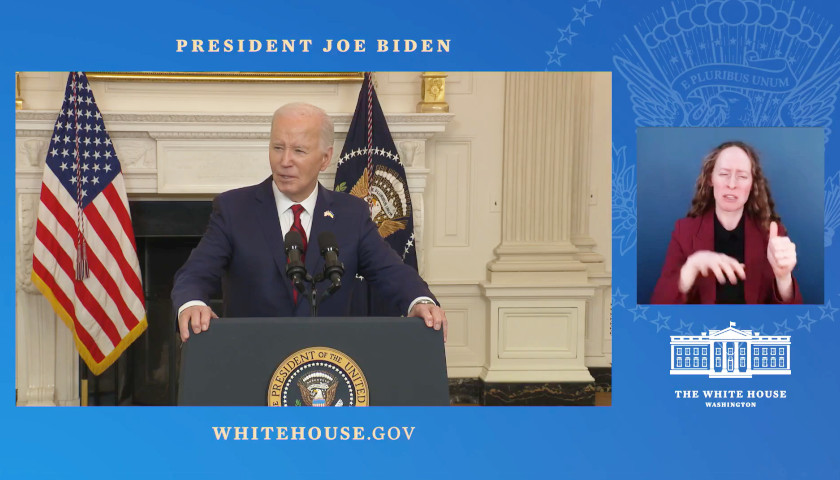Live from Nashville, Tennessee Thursday morning on The Tennessee Star Report with Michael Patrick Leahy – broadcast on Nashville’s Talk Radio 98.3 and 1510 WLAC weekdays from 5:00 a.m. to 8:00 a.m.– Leahy was joined in studio by former Vanderbilt and Princeton professor Dr. Carol Swain.
During the second hour, Dr. Swain analyzed current data with Leahy commenting that she found these numbers to be lesser than that of traditional influenza cases and in relation to past epidemics. She further questioned the overreaction of the coronavirus citing possible political purposes.
Leahy: We are joined now by our very good friend and all-star panelist Carol Swain. Former Vanderbilt professor. Good morning Carol.
Swain: Good morning.
Leahy: Well, we’re in the land of social distancing and usually you are in the studio. At least for a period of time, our all-star panelists will not be in the studio. We miss you, Carol. It’s more fun having you in the studio than not.
Swain: Well, I miss being in the studio. I’m hoping that the audio works out well.
Leahy: Here’s the thing. Let’s take a look at this Carol. You put out a very interesting little chart the other day and the chart basically asks the question, are we overreacting? Are we overreacting to the public health threat of the coronavirus pandemic?
Now it does seem to be increasing the raw numbers are increasing dramatically. But as I said earlier, it looks like they seem to be in the United States clustered in certain states and certain counties. The big cluster being in the state of Washington. The state of California and the state of New York. Tell me what your thoughts are on the reaction to this.
Swain: Well, my thoughts were expressed last week. I think there has been a bit of overreaction. If you look at the number of deaths worldwide in the United States, the number of people who recover after they get it and what has happened in past epidemics.
Leahy: Yeah, and that chart that you were looking at. It’s sort of one of the key things to me on this Carol has to do with the reported mortality rate of COVID-19. Let’s look at international data. China, you can’t believe a word they say.
I look at the numbers from China and I just don’t believe them. I just don’t believe them. And similarly Iran. Now Italy and Spain I think we can sort of believe them. Let’s take a look at the data in Italy. There are 35,000 confirmed cases of coronavirus in Italy. And there are basically 2,978 confirmed dead. That’s a real number and its about seven percent of those who have had it.
Swain: I have a response to that.
Leahy: Sure. I’m curious.
Swain: I’ve been talking with my friends at the Epoch Times and they told me that Italy, Canada, and a number of other nations that they did not react quickly like the United States because they believed the false reports that came out of China.
They kept letting those planes full of Chinese nationals and people going back and forth to come into their country. And by the time they reacted it had already spread. So I don’t know how much we can read into that.
Taiwan, by comparison, knew not to trust the Chinese, and so they have had very few cases because they immediately shut down their borders. So I think that you can’t really compare the United States to Italy because we reacted very quickly.
Leahy: Well, and this is interesting because in terms of reported cases. And to support your argument on this Carol look at South Korea which has a border with China. There have been 8,500. And I believe the data from South Korea.
Swain: And Taiwan.
Leahy: Let’s look at South Korea first. I’m trying to find the data on Taiwan. This is from NCOV2019.live. This is actually a real-time database that is very well presented. It’s been put together by, wait for it, from a high school kid in the state of Washington.
It’s probably the best real-time summary of data that I’ve seen. There are a couple of others. We link to worldometers if you go to Tennesseestar.com you can see our coronavirus 2020 report. But let’s take a look at South Korea.
This is how we are going to analyze how to respond to this. 8,565 confirmed cases in South Korea. And it moved there quicker than it did in any other country other than China. 91 deaths in South Korea. That is basically one percent of the population.
Now that’s still pretty high. So that’s South Korea. Now let’s go back up and see where we are right now in the United States. 9,176 confirmed cases. 154 deaths. Of the confirmed cases then Carol that’s about 1.5%, right?
Swain: Most of those people in the United States will recover and when you look at the deaths in the United States last week they were making much ado about the 82-year-old woman with emphysema. I believe I heard that she was a smoker. She had all sorts of other ailments and died.
Leahy: Sure.
Swain: And I believe that all of this is being hyped up for political purposes. And we’re doing something that some outside invaded nation wouldn’t be able to do and that is to be able to shut down the United States and destroy our economy by the overreaction.
Leahy: Well yes. Having said that, however, the data shows that right now 1.5% of everybody who has tested positive has died in the United States. That’s far higher than the less than one-tenth of one percent.
Swain: That’s because you’ve been testing the people that were sick.
Leahy: Yes. Yes. This is actually of confirmed cases is my point on this. This is actually of confirmed cases is my point on this.
Swain: I’m still not impressed. I’m not impressed because a lot of those people again had pre-existing conditions. Some of those cases from the US 27 or 28 came from a nursing home. And what I’ve been told is that were a lot of Chinese workers in that nursing home that worked in other places, and they were pretty much spreading it.
I just think if we are realistic, and we look at the number of people that die from the flu. The number of people that died of HIV-AIDS. The number of people that have died of other things that we didn’t understand. This is minuscule. It does not justify shutting down the city.
Or shutting down cities and shutting down the nation. I think for President Trump because of the Democrats and because its an election year he had to do the things he’s done. Surely it slowed the number of deaths.
But what are we aiming for like zero when people are dying every day from all sorts of things and life and death is part of a cycle. As a Christian, God did not give me a spirit of fear and I think the whole world is gripped with fear and that’s not coming from anything that’s good.
Leahy: It is fear-based upon data OK? Let’s go back to this point. I don’t know the answer but lets kind of play this out.
Swain: There are 350 million people in America and how many did you say died?
Leahy: So far 154 have died. So far. But let me continue with this a little bit. Back to the danger of this particular virus. Of those that have tested positive 1.5% of them have died and that is about 15 times higher than the mortality rate of influenza.
When you look at this Carol, and you look at the United States where do you see the peak will be? Again, you’re not an epidemiologist but you are a former political professor of political science so you know data. Based on the growth rates that we’ve seen, where do you think the peak of this will come over the next 30 days?
Swain: First of all Michael Patrick, first of all…
Leahy: (Serious voice) Yes, Professor Carol Swain.
(Laughter)
Swain: Did you tell me that 100 of the people that tested 1.5% have died?
Leahy: Of those who have tested positive so far yes. Right.
Swain: I would argue that because we had a shortage of tests the people that came in and asked to be tested were people that were already sick.
Leahy: Yes.
Swain: So I think that now that we are doing mass testing that ratio will go down dramatically because it’s based upon a sample of people that were already sick.
Leahy: So you make the same argument that a professor at Stanford University makes. This guy is Professor Ioannidis, and he’s got a Ph.D. in bio-metrics and a medical doctor and makes the same argument.
Listen to the full second hour here:
– – –
Tune in weekdays from 5:00 – 8:00 a.m. to the Tennessee Star Report with Michael Patrick Leahy on Talk Radio 98.3 FM WLAC 1510. Listen online at iHeart Radio.









Thank you, Carol Swain, for calling “foul”!
The flaw in all of these prognostications is that we know the numerator (number of deaths). Well, we know what we are told. But, we don’t know the denominator (total population with Covid-19). Time will tell who is right.
The one positive thing about this “issue” is that it is bringing out the horrible mistake that we made by outsourcing our manufacturing capabilities to China.
Xi doesn’t care if a 100 million Chinese have to die to get what he wants, world dominance by the Three Kingdoms!